A Blow To The Brain
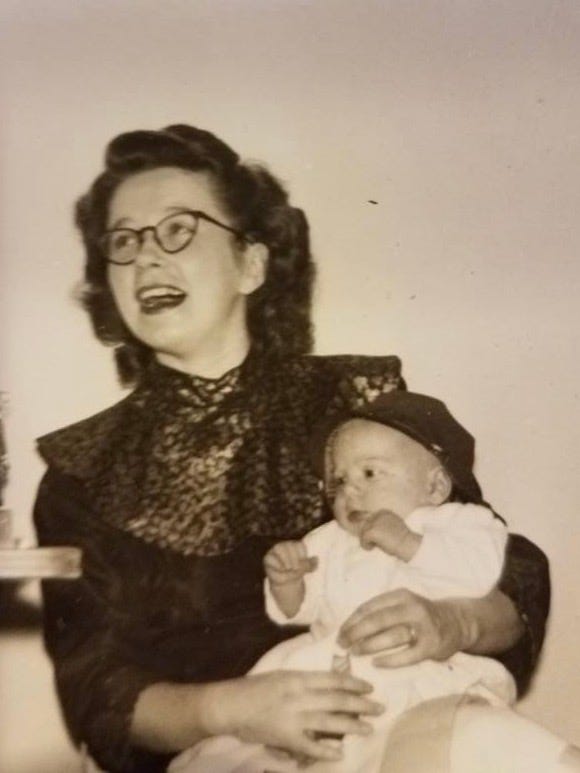
In early May of 1950, Mickey Brown was 24 years old and very pregnant with me, counting down to my May 23rd date with history. She, along with my dad and my older sister Cheryl, lived in the northwest Washington hamlet of Sedro Woolley. Their home was a shake house built two or three decades earlier for workers at the local logging mill.
One day, while Mickey was doing dishes with her hands in soapy water and standing slightly to the left, a storm blew through. She jumped when she heard a loud clap of thunder and simultaneously saw a flash of lightning outside the window. The old house didn’t have a lightning rod; however, even if it had one, it wouldn’t guarantee protection against the erratic nature of ball lightning.
Suddenly, a glowing, crackling orb bounced in through the closed window. It found its way to the metal trim on the linoleum countertops and buzzed around it like its own personal racetrack before leaping toward the dining room window and disappearing across the neighbor's yard. As it passed, it kissed the side of my head. This encounter left me born with a streak of white in my dark hair—a mark I still see from time to time when I let my gray grow out too far. Little did Mom know, this event would connect me to a long line of electrical encounters.
Needless to say, Mickey let out a yelp as she jerked her hands out of the water. My Grandpa Kalles had witnessed this whole event from the doorway; he hurried over to check on both her and hr baby, but he was mostly amazed by what he had just seen. The electric kiss on my head, a jolt for Mickey, joined the other strange sights Grandpa Kalles had witnessed in his lifetime, and now, as I try to understand my own relationship with those electric threads, I find myself drawn into the currents of his past, to a time of, literally, shocking discoveries.
Grandpa Kalles Gets a Shock
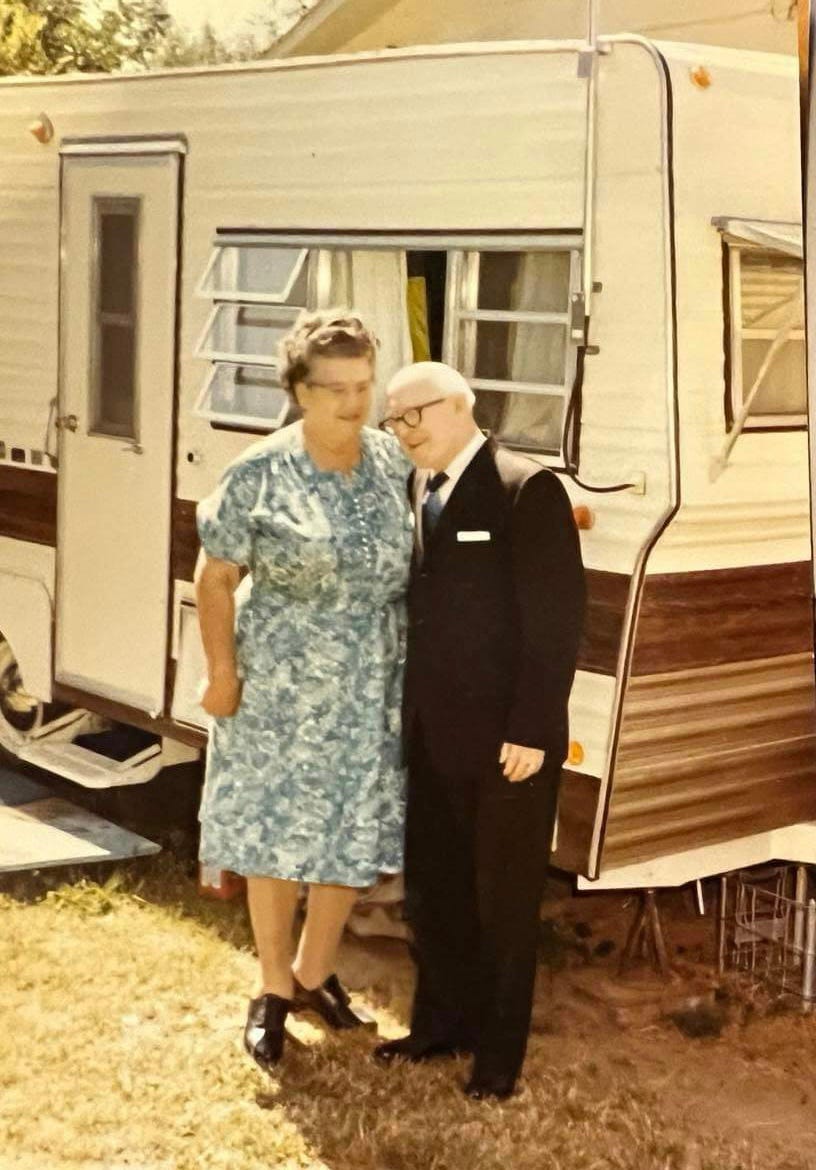
Dusk gathered early in the bunkhouse under the big, old cedars in the dim light once called the Green Hell. My grandfather, Frank Kalles (1892-1977), worked the Skagit Valley old growth as a timber faller in those days. He was also a bookworm, willing to be changed by a new idea. He was one of the few men who didn’t drop like a fresh-cut Doug-fir into his bunk after dinner. An oil lamp set in a niche just under the rafters shed a low, flickering light over his book. Electric lights were a luxury of the urban lowlands in those days.
A decade into the new twentieth century, the owner snaked a line first to the shake house that served as company headquarters, then to the mess hall, and as an after-thought, and because there were a few feet of wire left on the huge wooden spool, out to the bunkhouse. There it ran the length of the room, dangling one bare bulb in the middle.
The first time Frank saw the electric light, he immediately grasped its potential to extend his reading time. Hooking his thumbs into the top of his canvas pants, he stared at the wire-and-bulb contraption for a long time, figuring it out. A mechanically-minded fellow, he reckoned that a second, shorter wire could be spliced into the main, run over to his bunk, and a second light bulb rigged. He obtained the permission, the light bulb, the socket, the wire, and a pair of wire-cutters for the job.
None of the boys, including Frank, knew anything about electricity; it was the new technology on the block, so they stood around and watched with interest as Frank attempted the maneuver. Frank reached boldly up with the wire-cutters and clamped down. The two live wires flipped through the air: Frank landed on his butt, electricity crackled, and the boys yelled and scrambled to get clear of the hot lines. Someone figured to switch the light off. On the floor in the dark, Frank roared with surprised laughter at his own ignorance. “We didn’t know a darn thing about electricity in those days,” he said later.
He told that story on himself for the rest of his life. Electricity had caught his imagination. He was fascinated by Ben Franklin’s famous flying-a-kite-in-a-storm story, and he told it to us kids story-chained together with his own memory.
Ringing Ben Franklin’s Bells
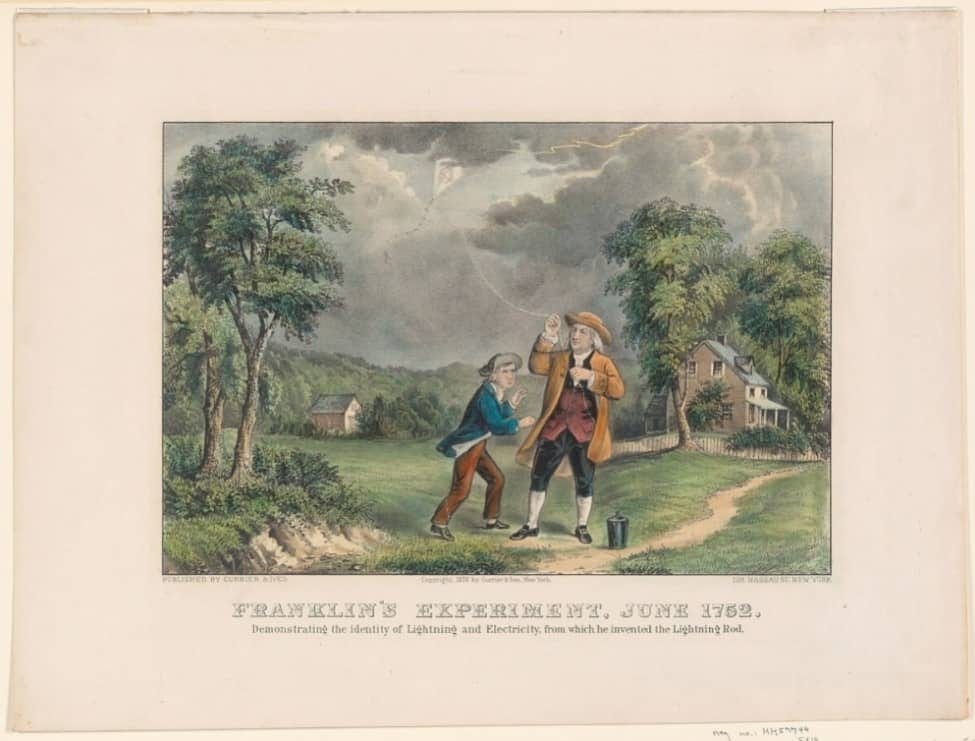
Because of Grandpa Kalles’s repeated stories, sometimes I have to stop and think about Ben Franklin and his fascination with electricity. Sometimes we forget that Franklin gave us the beginnings of the vocabulary of electricity: battery, conductor, condenser, charge, discharge, uncharged, negative, minus, plus, electric shock, and electrician gave a voice to the power.
The whole business about standing with the kite in the storm and the sparking key is a visual myth, of course, based on popular 18th century illustrations of the famous experiments. If Ben had tried it like the pictures show it, he’d have been electrocuted like a rabbit. In fact, he was knocked senseless one time while trying to kill a turkey by electric shock. He described the feeling as, “an unusual blow throughout my whole body from head to foot…after which the first thing I took notice of was a violent quick shaking of my body, which gradually remitting, my senses as gradually returned.”
The proliferating media illustrations did lead people to think they could repeat the experiment just by looking at them. It captured the imagination of scientists across Europe and likely contributed to Georg Wilhelm Richmann's own research into atmospheric electricity. He was a Baltic German physicist working in Russia. Richmann was a pioneer in the study of atmospheric electricity. In 1753, he was conducting an experiment to measure atmospheric electrical phenomena during a thunderstorm in St. Petersburg. Tragically, he was struck by what is believed to have been ball lightning. Thousands of volts of electrical energy came down the wire, through his body and into the ground, boiling the water inside his cells on the way, a fate Mickey/Mom and I thankfully were spared.
The problem here is that the illustrators of that time couldn’t figure out a way to draw an action which takes place both inside and outside a structure, like lightning coming out of the sky into a house. Ben was actually in a house up in the second story. In an early version of the experiment, the wet thread from the kite passed under a nail in the window sash to a sparking key, and Ben was holding an enormous wad of insulating hemp rope. In a further development, the kite attracted electricity, and the current flowed along the wet twine to the key, which charged a Leyden Jar, storing the electricity he needed for his experiments.
The endless number of “false news” illustrations also missed the point of his experimentation, which was to demonstrate that electricity amasses any time atmospheric conditions change. The rain in the pictures was dramatic but misleading; rain wasn’t needed, and it was much better that lightning didn’t strike the kite.
Ben Franklin and my Grandpa Kalles were equally curious about the new science of electricity. I can imagine my grandfather watching Ben Franklin set up one of his experiments with great interest. Ben would explain to him what he was doing: "I have a nine-foot iron rod on top of the chimney. From the foot of the rod, a wire about the thickness of a goose quill comes through a covered glass tube in the roof and down through the well of the staircase. On the staircase across from my bedroom door, I've divided the wire and separated the ends about six inches. There's a little bell on each end. I have suspended a brass ball between the bells by a silk thread. Theoretically, when clouds charged with electricity pass by, the ball will play between and strike the bells."
Then Franklin would say to my grandfather, “Frank, go watch the storm coming from the attic window. Can we predict the atmospheric conditions that will ring the bells?”
The storm is still far away, yellow and purple on the horizon, the distant slant of rain a smear of gray from sky to ground. Grandpa throws open the attic window, sticks his head out and cranes to see the nine-foot iron rod vibrating above Ben Franklin’s house. He’s paying full attention to the tense quality of the wind, that whiff of ozone in the air. Then he sees the hairs on his arm rising. He doesn’t know exactly why, but he yells, “Those bells are gonna ring, Ben!” Down the stairwell in the hall, he hears the sound that will one day light a bunk house in the Northwest woods, the soft sound of bells rung by the power of a gathering storm.
The Electric Fence
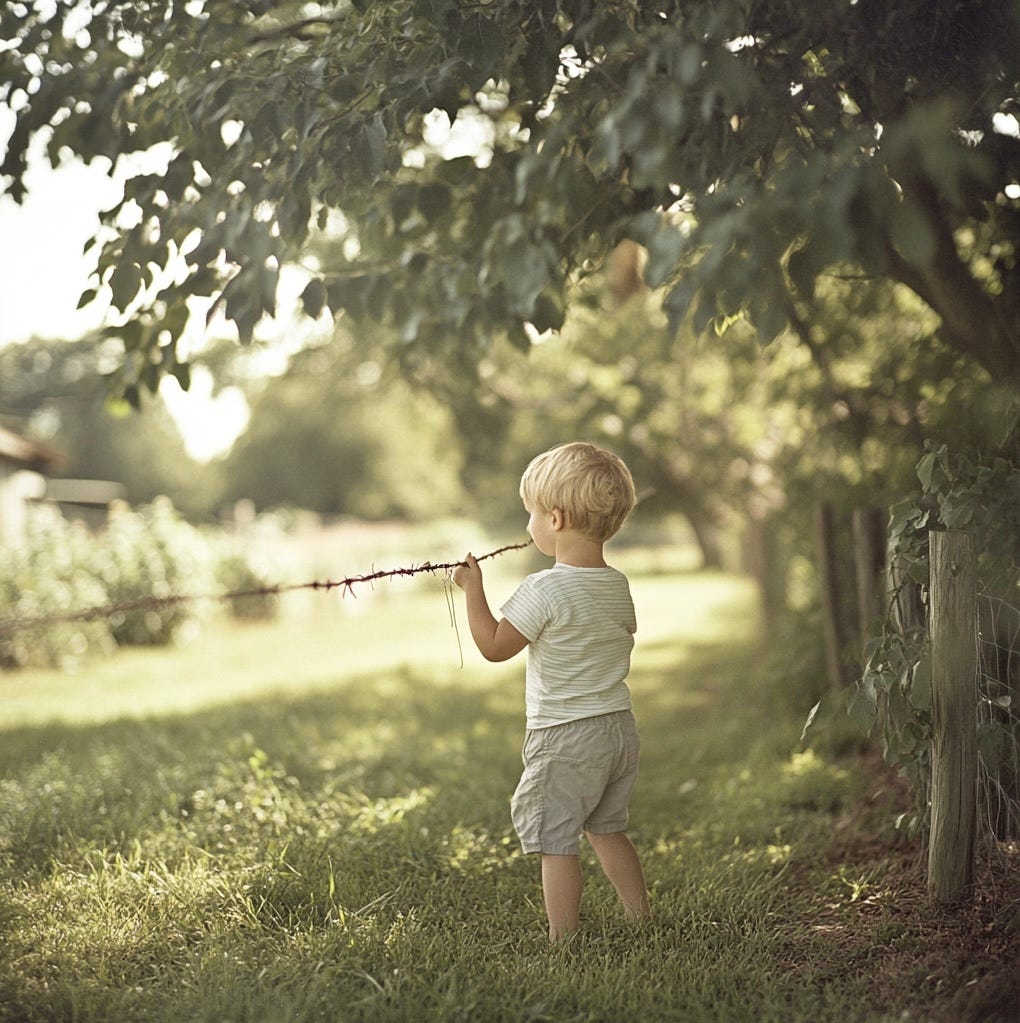
Under the sprawling shade of the ancient mulberry tree, where the backyard met the creek, my dad Warren erected an electric fence. A thin wire, strung between rough-hewn posts and threaded through pristine white insulators, hummed with a gentle, eight-volt current, enough to deter a wandering horse.
Late one summer evening, as we children played hide-and-seek among the weeping willows, a scene unfolded that I never forgot. Little Mark Wilson, barely two years old, reached out and grasped the wire. His small body jerked with each pulse of electricity, his face a picture of innocent curiosity. He did not cry, he did not pull away. To him the shocks were a new and interesting sensation.
It was only after his sister, her voice laced with concern, asked, “Doesn’t it hurt?” that he looked at her, his eyes mirroring her worry, and began to cry.
I remember the feeling of unease as I watched, and how we all learned that night, that what adults know to be pain, is not always known to a child.
The Mar-don Resort Incident
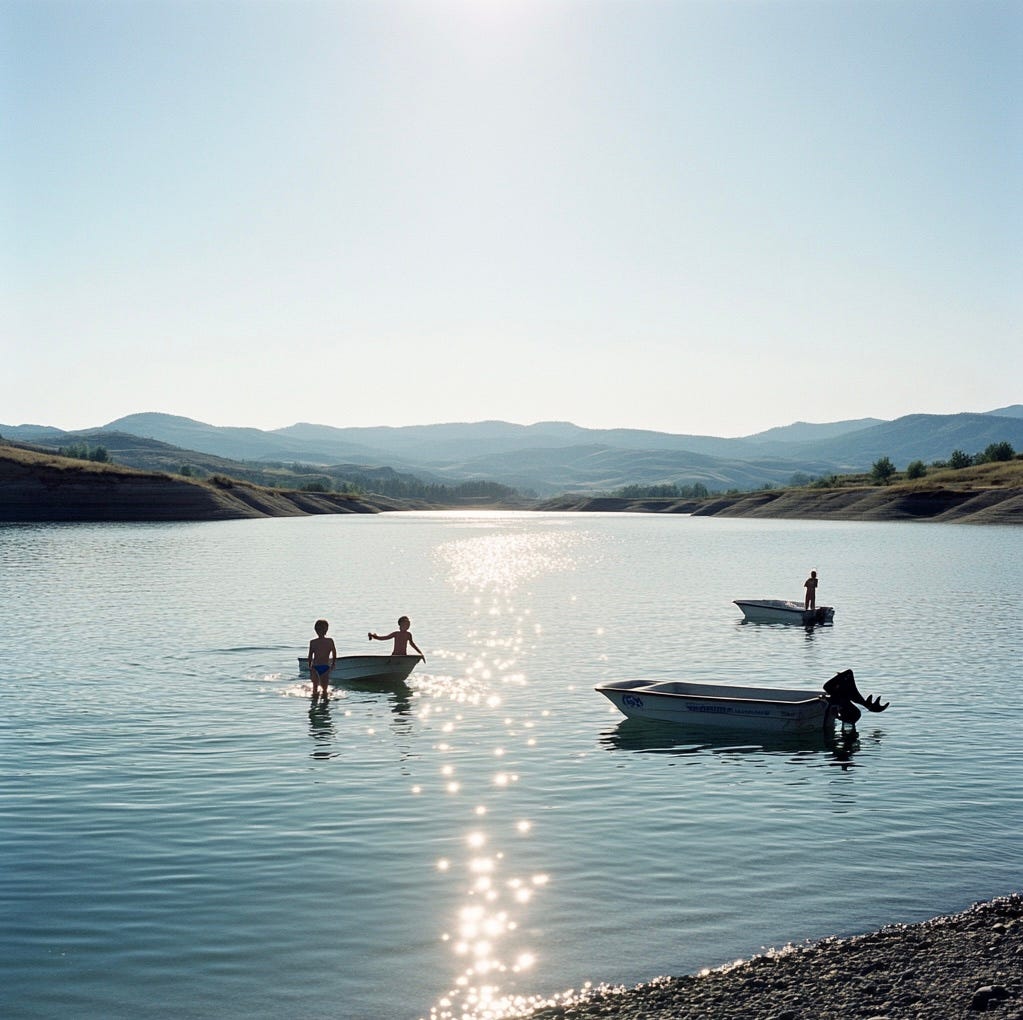
The innocence of childhood, and the incomplete understanding of danger, was shattered on a hot summer day at Mar-don Resort.
In the 1950s, the Mar-Don Resort was a scruffy scatter of campsites scratched out of the alluvial gravel of Potholes Reservoir, almost in the center of Washington State, 16 miles southwest of Moses Lake on the west end of O'Sullivan Dam. A ramshackle structure served as an office and store for camp supplies. A few RV sites had been wired, and a small pump house hummed in a ditch bringing water up from the lake in an exposed irrigation pipe.
My brother, Lisle, was a dark-haired toddler of three or four, and I—that same dark, unruly hair—was seven or eight the year we camped at Mar-Don over Memorial Day weekend. Lisle and I went for a walk along the lakeshore beach as kids do, picking up bits of shiny flint and oddly shaped concretions of clay. When we came to the water pipe, we just sprawled on top of it and heaved ourselves over.
The day was hot, so we were in our little bathing suits, splashing in and out of the water. Potholes Reservoir stretched almost to the skyline from a kid’s-eye point of view. The sun shimmered and shook over the surface. Aluminum fishing boats elongated into shiny dinosaurs or sharks. One disappeared into a distant indigo mist, then reappeared with a black dog standing like a plastic toy on the stern.
Lisle and I heard Mom’s lunch-time call to return, so we walked more briskly back the way we’d come, kicking up water as we went. Lisle approached the water pipe first. He crawled over; then, I was astonished to see him flung sideways into the air to land hard on his back.
I ran to the pipe to get over and help him. I leapt up with my whole body and felt the animal that is electricity reach out and suck me down. It was eating my soul alive. I struggled to move but could not. It sucked and sucked like the ten black leeches I had seen on my sister Cheryl’s leg at Stake Lake. As I tried to scream and struggle, the creature hugged me closer, I closed my eyes as it went for that last long drink that was my life.
As quickly, it shoved me away. Like my brother, I flew through the air and landed on my back, beyond limp, drained almost of all life, unable to move or breathe. In the distance, I heard my mother call out and the sound of my father’s footsteps running toward me.
Was it pain I felt? I didn’t have a very complete vocabulary of pain at that age. What I felt was, I think, horror. I had met the monster under the bed, and it had almost killed me. So also, terror, and incomprehension. The memory lives not in my head but in my body where I felt my own death at an early age and someday will again.
The Dinner Party
At a dinner party decades later, I told the Mar-Don story and opened it up for discussion. “What’s up with this? What happened?” I asked.
Mike, a graphic artist, jumped right in with both hands twisting first one way and then the other, toward and away in a pattern that demonstrated, he said, “Those magnets you played with as a kid. If the poles are opposite, the magnets suck together. If they’re the same, they push away from you. The electricity in the pipe switched polarities at random, sucking you on, forcing you off.”
I nodded with more comprehension than I felt. “But why does it suck the body?”
Mike explained about lightning coming up from the earth and down from the sky. I refilled my wineglass.
Jeff, who is a doctor, added that in the United States current alternates at about sixty times a minute, roughly correlating to the electrical pulses of the human muscular system. It is that strange correlation that enhances the affinity of AC current for the human body. “It’s called tetany,” he said,” like tetanus, which refers to the rigidity of the muscles of tetanus victims.”
“But why were there alternating currents of any kind in that pipe?” I wondered.
“It shorted out,” Mom told me later when I asked her about the incident. “I read the owners the riot act, and the pipe was buried underground the next time we camped there.”
The conversation at the dinner party table moved inevitably, it seems, to ball lightning. Peter told a story about a college friend, Sid, who saw his mother in the bathtub during a hot summer storm. Ball lightning came in the bathroom window, bounced off the floor and flew back out, leaving the wet woman shocked only in mind. Sid looked back to that moment when he declared himself a physics major.
That reminded me of the time our whole family packed the car and left our Wenatchee, WA home just before dawn. We wanted to drive west over the hump of the Cascades to catch an early ferry out of Anacortes to Friday Harbor on San Juan Island for a long Memorial Day weekend. As we came down to the stop sign at the bottom of Horse Lake Road, the main street was empty. Dawn touched the graceful crown of Burch Mountain with a creamy pink and gold, which stood in glistening contrast to the dark, receding cloudbank of last night’s storm.
I don’t know who saw it first, but we stayed parked there, all of us silent as a mysterious oblong of light gathered on the flank of Burch Mountain and slowly rolled our way, in and out of view, growing larger as it came nearer. Fifteen or twenty seconds later, it hit the road somewhere around Monitor, then rolled majestically across the bridge in front of the car, then disappeared down Wenatchee Avenue, bouncing gently, big as a house, silvery-white with pulses of snaking magnetism. It was like looking into a crystal Christmas tree ornament that glowed and crackled with blue lines.
“A flying saucer,” Mom said.
“Ball lightning,” Daddy said.
“And that’s probably all the family psychology you need for self-knowledge,” my husband said, as I finished my tale. Then somebody else had another ball lightning story, and the conversational ball just kept rolling from the electrical wiring of one person’s memory to another, stories joining us in an alternating current of what my Grandma Kalles used to call fellowship.
As a flash of that lightning called laughter flowed over me, some other light rose up from the dark, a memory of another dinner party a dozen years before in Fort Collins, Colorado. I met a couple there in their thirties; more than that I couldn’t say because what was unusual about them both was the stricken looks on their faces. They smiled, shook hands, arranged themselves in poses of calculated nonchalance, but they only contrived to look like terrified mannequins with faces frozen in a rictus of pleasantry. To be in their presence was to stand in the shadow of dread. The conversation skated on surfaces, offering no tool for seeing beneath this ice.
After dinner, the man began to speak compulsively. I felt like the guest as the Ancient Mariner was compelled to tell his story; I was just as compelled to listen. “I was raising rabbits as a commercial venture up on the Cache l’ Poudre. I wanted a quick, humane method of slaughtering them and rigged up a system with two wires that went either side of their heads and electrocuted them.”
The man glanced at his wife, who had locked her face into a tetany of normalcy. I thought she was going to faint. Certainly I didn’t like where the story was going. I wish now I’d followed my instinct to just get up and leave the room as one may go to the bathroom during the violent scenes in a movie.
The story plowed inexorably on: “One day I trained our eleven-year-old son Aaron to help with the rabbit slaughter. He was doing fine. I thought he understood the technique and the danger perfectly. I left the rabbit house for just a few minutes to do some chores. When I came back, I found him on the floor, dead, electrocuted with my own invention.”
I wanted to be able to say something reassuring like, “It wasn’t your fault. You need to forgive yourself,” but when you look into the eyes of a man who has electrocuted his own son, you see into the Edvard Munch scream that is the maw of the universe. The wife’s face twisted into the shapes of ancient anguish, “Why would God let it happen?”
This wasn’t my dinner party and as struck by the bolt of their story as I was, it wasn’t my place to say, “It was an accident. Statistically random, unguided by any power other than the stupidity of father and son alike. No one’s watching out for you but yourselves. You can’t get over this; you never will.”
This is a story I have hated so much I haven’t told it until now. But while one story ended in tragic finality, another experience showed me that there may be more to the end of life than just the end.
The Sparrow’s Story
One crisp October morning in California in the early 1980s, a shower of hot pink bougainvillea leaves scattered as I opened the pool gate. The still, reflective aqua mirrored the sky, and, beside it, a small sparrow fluttered erratically, a broken wing trailing blood. Compassion, swift and wordless, moved me. I scooped the small bird into my hand, leaned over the pool, and gently submerged it. The frantic pulse of its tiny body stilled, and then, a jolt, an electric current surged through me, from my hand up my arm, a tingling in my throat, and a release through the crown of my head. For a timeless moment, I felt a vast, open space within me, as if air itself were flowing through my very being. I straightened, the sodden weight of the sparrow in my hand, and, in that instant, I understood that the soul is a spark, an electrical essence connecting all living things. That feeling, that charge, has stayed with me, a reminder of the unseen energy that flows through every living thing.
Electricity, in its capricious dance of power and danger, illuminates not only the physical world but the hidden currents of our lives. From Grandpa Kalles's laughter to life’s devastating shocks, we are all conductors of experience.
Perhaps, in the end, the true current is not the pulse of electricity, but our shared capacity to find light and meaning. Our stories weave through our lives, illuminating memories like electric threads.






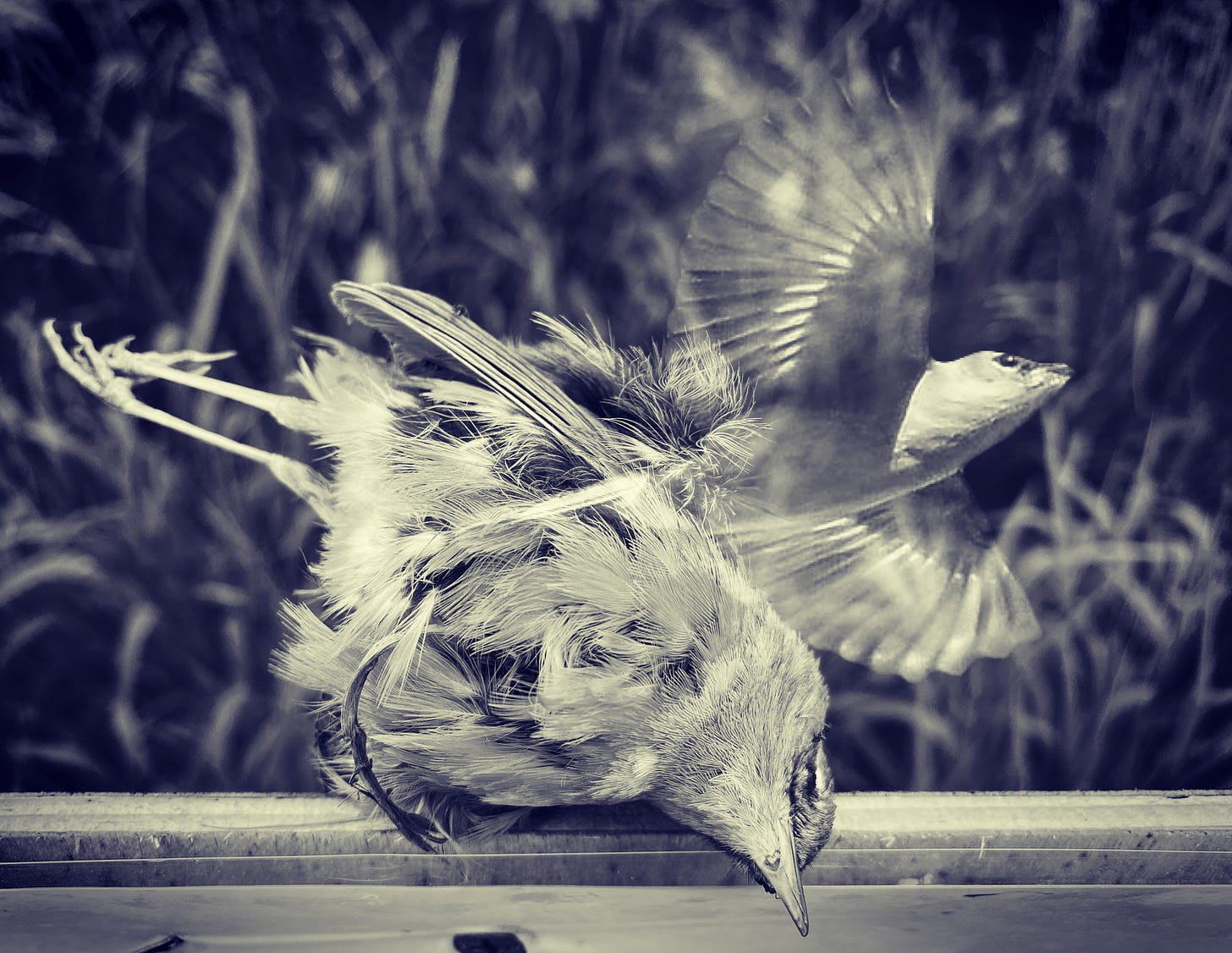

I enjoyed the first story most of all. The "girl struck by lightning" an opening chapter in your next novel!
Beautifully written, Sandy. I love your many uses of electric imagery throughout the story. Now I want to see ball lightning — from a safe distance, of course. I can remember testing an electric wire fence, like the one around Lance’s pasture, with a stalk of green grass to feel the slight pulse, rather than using my hand. My horse Jubie, who was shorter than Lance, would ignore the shock of the wire as she dashed under it. I could not trust leaving her in there with Lance.